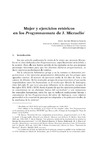Please use this identifier to cite or link to this item:
https://accedacris.ulpgc.es/jspui/handle/10553/73374
| DC Field | Value | Language |
|---|---|---|
| dc.contributor.author | Moreno García, Jesús Alexis | - |
| dc.date.accessioned | 2020-06-18T12:35:56Z | - |
| dc.date.available | 2020-06-18T12:35:56Z | - |
| dc.date.issued | 2019 | - |
| dc.identifier.issn | 0870-0133 | - |
| dc.identifier.other | Scopus | - |
| dc.identifier.uri | https://accedacris.ulpgc.es/handle/10553/73374 | - |
| dc.description.abstract | This work analyses how the female figure is described in the exercises of the Progymnasmata Aphthoniana in usum scholarum et studiosorum eloquentiae by Johannes Micraelius, particularly those in the fable and narrative parts. Our analysis reveals that the presence of women in Micraelius’ examples is remarkable and, besides, that women are always depicted positively rather than considered a punishment for mankind. It may be concluded, therefore, that men and women share the same vices and virtues, these not being exclusive of one gender or the other. In fact, Micraelius draws up a balance between vices and virtues; he opposes destructive and alienating love to castitas, here understood either as abstinence from sex, fidelity to one’s spouse or confluence of interests and life. Likewise, Micraelius opposes superbia (the most outstanding vice and cause of destruction, as it reveals the desire to resemble the gods) to pietas, that is, to man’s submission to God, which brings peace and harmony. | - |
| dc.language | spa | - |
| dc.relation.ispartof | Euphrosyne | - |
| dc.source | Euphrosyne [ISSN 0870-0133], n. 47, p. 367-379 | - |
| dc.subject | 620205 Retórica | - |
| dc.subject.other | Progymnasmata | - |
| dc.subject.other | Rhetorics | - |
| dc.subject.other | Female virtues and vices | - |
| dc.subject.other | Micraelius | - |
| dc.title | Mujer y ejercicios retóricos en los Progymnasmata de J. Micraelio | - |
| dc.type | info:eu-repo/semantics/article | - |
| dc.type | Article | - |
| dc.identifier.doi | 10.1484/J.EUPHR.5.125307 | - |
| dc.identifier.scopus | 85131672645 | - |
| dc.contributor.orcid | NO DATA | - |
| dc.contributor.authorscopusid | 57734796600 | - |
| dc.description.lastpage | 380 | - |
| dc.description.firstpage | 367 | - |
| dc.relation.volume | 47 | - |
| dc.investigacion | Artes y Humanidades | - |
| dc.type2 | Artículo | - |
| dc.utils.revision | Sí | - |
| dc.date.coverdate | Enero 2019 | - |
| dc.identifier.ulpgc | Sí | - |
| dc.contributor.buulpgc | BU-HUM | - |
| dc.description.sjr | 0,101 | - |
| dc.description.sjrq | Q3 | - |
| dc.description.ahci | AHCI | - |
| dc.description.erihplus | ERIH PLUS | - |
| item.grantfulltext | open | - |
| item.fulltext | Con texto completo | - |
| crisitem.author.dept | GIR IATEXT: Filología Clásica "Juan de Iriarte" | - |
| crisitem.author.dept | IU de Análisis y Aplicaciones Textuales | - |
| crisitem.author.dept | Departamento de Filología Hispánica, Clásica y de Estudios Árabes y Orientales | - |
| crisitem.author.orcid | 0000-0002-3792-8887 | - |
| crisitem.author.parentorg | IU de Análisis y Aplicaciones Textuales | - |
| crisitem.author.fullName | Moreno García, Jesús Alexis | - |
| Appears in Collections: | Artículos | |
SCOPUSTM
Citations
1
checked on Jun 8, 2025
Page view(s)
163
checked on Mar 15, 2025
Download(s)
143
checked on Mar 15, 2025
Google ScholarTM
Check
Altmetric
Share
Export metadata
Items in accedaCRIS are protected by copyright, with all rights reserved, unless otherwise indicated.
